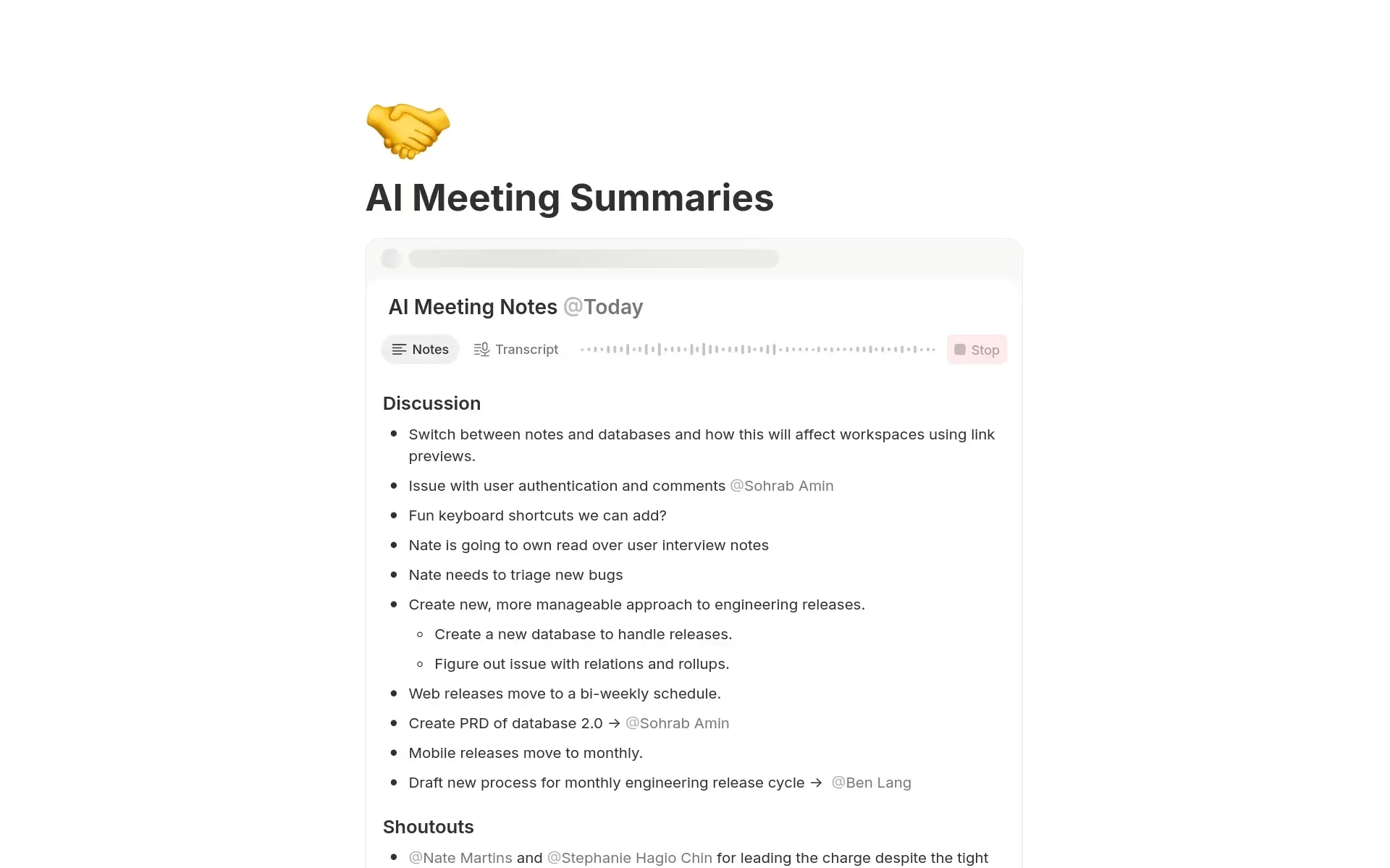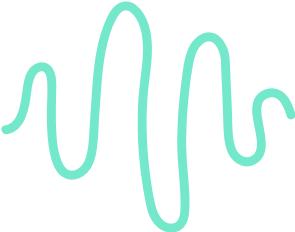Notion Meeting Notes : a Complete Guide

Get the work done for any meeting
Meeting transcription, AI custom notes, CRM/ATS integration, and more
With Notion AI Meeting Notes, you can now record, transcribe, and summarize your meetings without leaving your workspace.
But how does it work exactly ?
In this article, we’ll walk you through what Notion’s meeting-notes features can do, how to set them up, and how to troubleshoot common issues.
What is Notion Meeting Notes?
In 2025, Notion launched its integrated AI assistant which includes the Meeting Notes feature. It's built right inside Notion so your meeting notes, action items, and projects stay connected.
Here’s what it brings to the table for you:
- Real-time transcription of both microphone and system audio. Whether you’re on Zoom, Google Meet, Microsoft Teams or even in person, Notion listens in.
- Instant conversion of your meetings into structured summary and action items. After the meeting ends, Notion AI handles the heavy lifting so you can move forward.
- Seamless integration: Because the feature lives inside Notion, you can link your meeting notes directly to tasks, projects and databases without switching apps.
How to Set Up & Use Notion AI Meeting Notes

Here’s how you—step by step—set up, launch and integrate Notion’s meeting-notes feature :
Step 1: Create your meeting notes block
Open a page in Notion (desktop app). Type /meet or choose the “Meet” block from the menu. This will create a dedicated meeting-notes block where transcription and summary will happen.
Once it appears, you’ll usually click “Start recording” (or equivalent) to begin capturing audio. The system listens to both your microphone and system audio—so when you’re in a video-call, the tool can pick up the voices.
Step 2: Choose your meeting format and structure
Before you begin the call, modify the meeting-block settings. Notion lets you pick from meeting formats like “Team Meeting”, “Stand-up”, “Sales Call”, “1:1” etc. This matters because the chosen format helps the tool structure the transcript and summary according to expected flow.
Also: decide where the notes will live. You might attach the meeting notes to a dedicated “Meetings” database or link it to a project page. In Notion’s calendar settings you can set a default location for new notes so they’re organised automatically.
Step 3: During the meeting — engage, record, collaborate
With recording started, you focus on the meeting itself—listening, speaking, engaging. Meanwhile, you or your team can add manual notes in a “Notes” tab or section inside the block.
Why do this? Because Notion’s AI uses both the live transcript and your manual notes (including tags, @mentions etc) to generate a better summary and actionable items.
Tip: Use @ mentions inside your notes to tag colleagues or decisions. The system will recognise those and turn them into action items or follow-ups.
Step 4: After the meeting — review, link, follow up
Once the meeting ends (and you click “Stop recording”), Notion generates: a full transcript, a structured summary, and a list of action items. The summary will usually categorize discussion topics, decisions and next-steps—so you don’t walk away wondering “what just happened?”.
Now you link the meeting note to the relevant project, task or database. If you set up a database template earlier, your note is already in the right place. From there, convert action items into tasks, assign ownership, set dates. Use database relations and roll-ups so that your meeting notes connect to your bigger work system.
Step 5: Best practices to make this work for you
- Create a template for recurring meeting types (e.g., weekly team sync, 1:1s). Pre-add the
/meetblock, agenda headers, tags. This saves you time. - Share the agenda before the meeting inside the Notion page, so participants come prepared and you get better discussions.
- Standardise where you store notes. Use one Meetings database with consistent naming, dates, tags. This makes searching later much easier.
- After meeting, assign follow-ups within the same workspace. Don’t leave action items scattered in chat. When they link to your tasks/projects, you increase accountability.
- Periodically archive old meeting-notes or clean up your database (e.g., filter by date or status) so you maintain a lean workspace.
Notion AI Meeting Notes Troubleshoot

Even the best tools can trip you up if you don’t know what to look for. When you use Notion AI Meeting Notes, you may run into a few hiccups. Here’s how you can fix them and keep your meeting-notes workflow smooth.
Issue #1: The command doesn’t appear or doesn’t launch
If you type /meet and the meeting-notes block doesn’t show, or you can’t start the transcription, it’s probably a setup or permission issue. According to Notion’s help docs, the feature must be enabled in your workspace settings.
What you should do:
- Check that you’re using the latest version of the Notion desktop app (and if on Mac, macOS 13 or later).
- Confirm that workspace owners have toggled on “AI Meeting Notes” under Settings → Notion AI.
- If using the browser only: note that system audio capture is limited or unavailable there, which may cause issues.
Issue #2: Transcription doesn’t capture all participants / system audio missing
You want all speakers captured and the system audio (if you're on a video-call) included. Sometimes you’ll find the transcript only has your voice, or misses meeting participants. According to reviewers, Notion records system audio only through the desktop app and may miss audio entirely if you’re using headphones.
What you should do:
- Use the Notion desktop application rather than browser for full system audio capture.
- Make sure your system audio settings allow Notion screen & system audio access. If you’re repeatedly asked for permission, revoke then re-grant the permissions and restart the app.
- If attendees are using separate devices/headsets, make sure their voices are nonetheless coming through your system audio or mic. Otherwise, you may need a separate recording channel.
- For important calls (e.g., sales demos, client meetings), test the setup beforehand and ask participants to speak clearly and use unmuted mics.
Issue #3: No speaker labels or confusion about who said what
While the transcripts are created, you might find that speaker labels are missing (e.g., all text looks like one person) and that makes follow-up harder. A user review notes:
“It does not identify who’s talking.”
What you should do:
- When taking manual notes during the meeting, use
@mentionor note speaker names in your manual section so the AI can infer context. - After the meeting, edit the transcript if you need clear speaker differentiation. Though Notion doesn’t automatically label speakers, you can add clarity manually.
- Build your meeting template in Notion with a section “Speakers / Attendees” or “Key Quotes by…”, so you can assign ownership and avoid the ambiguous “someone said…” issue.
Issue #4: Consent, privacy, data storage concerns
Recording and transcribing meetings means you need to manage consent and data properly. Notion’s documentation warns about legal/regulation aspects of recording.
What you should do:
- Before hitting “Start” on the /meet block, verbally ask all participants for consent, or play the consent message included in Notion’s block settings.
- Check permissions: make sure meeting note pages have the correct sharing settings—who can view the transcript or download audio.
- If your workspace has data retention policies, set up automatic deletion of transcripts or audio recordings where required.
Issue #5: Notes don’t end up linked or actionable
You use the /meet block, you get a summary, but weeks later you can’t find the action items linked to a project. The value drops when notes live in isolation rather than your workflow.
What you should do:
- When you create the /meet page, ensure it’s in your “Meetings” database or template you’ve set up previously. That way it’s searchable and linked.
- Immediately after the meeting, convert action items into tasks with owners, due dates, and link them to the relevant project in your Notion workspace.
- Regularly audit your meetings database—archive old entries, tag decision-makers, cross-link to projects—to keep things clean and useful.
The Best Meeting Note Taker in Notion: Noota

It's often worth stepping beyond a basic note-taking tool. That’s where Noota comes in.
- Noota automatically records and transcribes online, phone or in‐person meetings, so you don’t have to worry about missing anything.
- It then delivers AI-generated summaries, key takeaways and action items — so you leave the meeting with clarity. You can easily customize & structure meeting notes.
- It connects to your tools (Notion,CRM, ATS, project management) so your meeting insights don’t stay stuck in a document—they flow into your workflow.
- It gives you on-demand access to past meetings via its “Ask Anything” feature: you can query details instead of re-watching the whole meeting.
Want to test a all-in-one Note taker ? Try Noota for free now.
Get the work done for any meeting
Meeting transcription, AI custom notes, CRM/ATS integration, and more
Related articles

Forget note-taking and
try Noota now
FAQ
In the first case, you can directly activate recording as soon as you join a videoconference.
In the second case, you can add a bot to your videoconference, which will record everything.
Noota also enables you to translate your files into over 30 languages.

.svg)
.svg)
.webp)

.png)


.svg)
